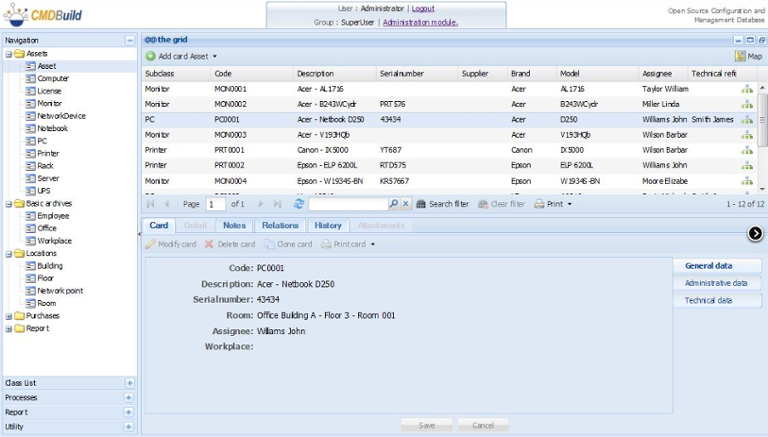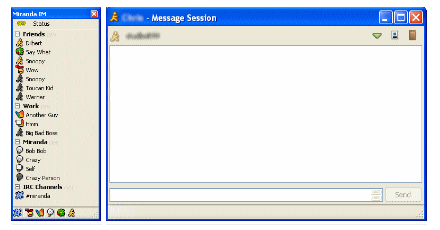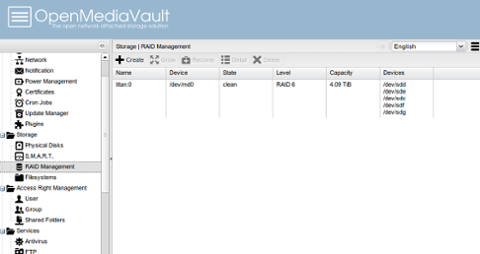Over at
SourceForge, the
August “Staff Pick” project is CMDBuild, a software platform that allows
developers to configure a custom database of assets and design-related workflow processes. The SourceForge editors sat down with one of the
project managers, Fabio Bottega, to discuss the project’s purpose and direction.
Tell me about the CMDBuild project. CMDBuild is an open source, enterprise Web application to model and manage your IT asset database. CMDB stands for configuration and management database but CMDBuild is more than an IT asset database. With CMDBuild you can configure and customize a complete IT governance environment, think of it as enterprise resource planning (ERP) for IT division management. Every organization needs its own data model; it’s own information technology infrastructure library (ITIL) and/or non-ITIL workflows, reports and dashboards, connectors, etc. With CMDBuild you configure your data model using our Web interface to create and connect a custom workflow. CMDBuild is like an “open source
Microsoft access” except that it’s an enterprise Web application, written in
Java, with a modern SOA architecture and a powerful workflow management system. The CMDBuild philosophy is to create complete configurability.
What made you start this? In 2005, the information systems division of the municipality of Udine (a town in the northeast of Italy where we are based) started a revision and optimization activity for some internal processes, according to ITIL “best practice” standards. The
CIO searched for an open source tool but could not find any, so he approached
Tecnoteca with the idea to start a new project to develop an
open source CMDB tool. The initial financial impetus to grow came from the municipality but it was a long and difficult path to get here.
Has the original vision been achieved? Compared to the initial CMDBuild objectives, we went much further faster than we hoped both in technical and in functional aspects, with one exception: the growth of a strong community. To begin with, contributions were very few because of the lack of English documentation. After we released
manuals in English, contributors localized 13 languages and some advanced users began helping users on the forum. Then code contributions began, with a new Web service CMDBuild and CMDBf compliance. But the project needs more help from the community for CMDBuild to continue to grow.
Who can benefit the most from your project? CMDBuild target users are medium to large public and private organizations (from 200/300 to 20,000/30,000 or more employees) that want to manage their IT governance in a controlled way.
What is the need for this particular asset management tool? The main use of CMDBuild is to manage the IT governance (assets and workflows) of an organization. However, thanks to its flexibility and architecture, CMDBuild is also a good solution for managing data and the workflows of non-IT environments. For example, we recently created and released the new
openMAINT software, a complete solution for the property and facility management (CMMS), on SourgeForge that started from CMDBuild. And some organizations use CMDBuild to manage and maintain vehicles, to manage artwork in museums, to manage workflow-based office practices, etc.
What’s the best way to get the most out of using CMDBuild? There are two things you can do: learn about the philosophy and the technical mechanisms of CMDBuild and have clear ideas about the best way to manage the IT division of your organization. To learn CMDBuild, I suggest starting with the overview manual and then switch to the administrator and user manuals. If you then want to study the workflow system, the Web service, and the external connectors there are separate manuals for each. I suggest the
ITIL approach to clarify the optimal way to manage the IT infrastructure of your organization. You must believe that a configured solution, which works exactly how your organization works, is better than a hardwired solution.
What has your project team done to help build and nurture your community? We opened a forum where we provide updated documentation with each major CMDBuild release, we organize events and publish slides and videos, and of course we make the updated source code available in real time. Then we take care of the “socials” by issuing a bimonthly newsletter, a LinkedIn group with over 300 members, and a dedicated channel on Twitter, YouTube, and SlideShare.
Have you all found that more frequent releases help build up your community of users? Yes, frequent releases enable users to obtain bug fixes, new features, and updates that keep users close to the project. CMDBuild has one or two major releases each year and a minor release about every two months.
What was the first big thing that happened for your project? After two or three years of life CMDBuild was chosen for some high profile public administrations in Italy (since Tecnoteca, an Italian company, is the brain child of CMDBuild), such as the State Attorney, the City of Bologna, the Regional Council of Tuscany, the Italian Chamber of Deputies, etc. From then on, thanks to these testimonials that supported the project in public events, word of mouth, etc., the CMDBuild circulation increased.
What helped make that happen? The open source license helped to achieve this result and the fact that the initial sponsor, the Municipality of Udine, is a public administration. Italian public administrations are required to always consider open source solutions in their software choices and when they find valid products they use them.
What was the net result for that event? A lot of
case studies,
testimonials,
events slides and videos.
What is the next big thing for CMDBuild? We are working on a new “mobile interface”, an app that can be used with smartphones and tablets. Then we will work to develop a “relations graph viewer”, a Web interface to analyze relationships and dependencies, impacts between assets, and infrastructures and services in a visual way.
How long do you think that will take? We will release the “mobile interface” in about three months and the “relations graph viewer” in about nine months.
Do you have the resources you need to make that happen? Availability of resources is a common problem in open source projects and we have this problem, too. We need more economic resources to grow the project, increase its working group, and provide it with new features. We can achieve this result getting more subscription by the organizations we support or by obtaining funding from investors.
If you had it to do over again, what would you do differently for CMDBuild? Every choice can be made in many ways but we are happy with the choices we made.
Is there anything else we should know? Yes, for some time an important part of our job was dedicated to balance the results obtained in Italy with those obtained in the global market (from the beginning more than 90 percent of the downloads came from countries other than Italy). Tecnoteca is based in Italy so we required more effort to access the global market. Now we support a lot of organizations around the world. Our goal is to grow our market even more through the Internet, new partners, and through awards, such as this SourceForge “Editor’s Choice” Project of the Month!
Related Projects
Image: tecnoteca srl
Upload Your ResumeEmployers want candidates like you. Upload your resume. Show them you're awesome.


